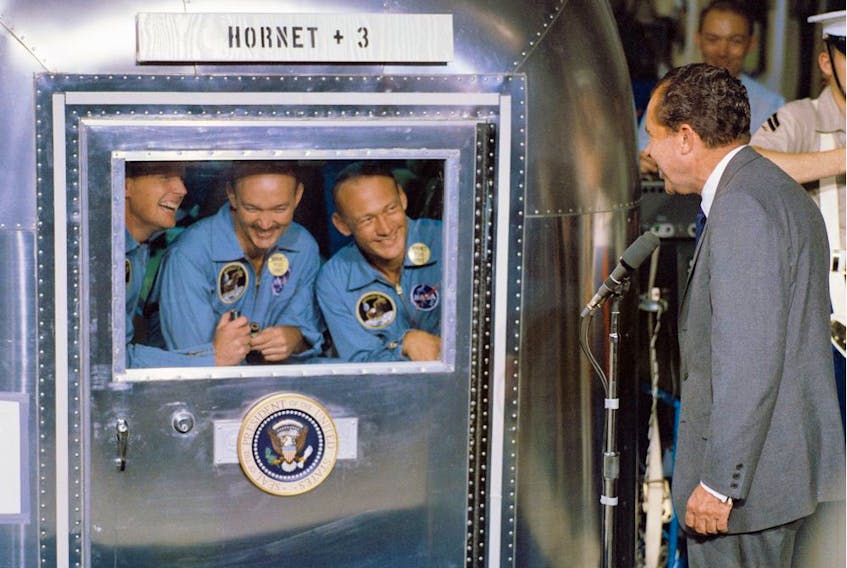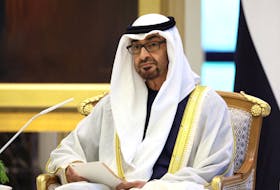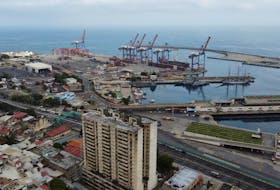• Among the objects left on the moon by the Apollo 11 mission are a gold olive branch, a defecation collection device, two urine collection assemblies (one large, one small), a vomit bag, tongs, a hammer and lunar overshoes. (NASA)
• The company that manufactured the spacesuits for the Apollo program also designed and made Playtex bras. ( Smithsonian magazine )
• The moon’s orbit around the Earth is getting larger, at the rate of about 3.8 centimetres a year. It is now, on average, about two metres farther away than it was in 1969. (Cornell University)
• Edwin “Buzz” Aldrin celebrated Communion on the moon with bread and wine. (National Geographic)
• The diameter of the moon’s largest crater, the South Pole-Aitken basin, is approximately 2,500 km, almost the distance from Ottawa to Miami. (Science magazine, google maps)
• From blastoff to splashdown, the Apollo 11 mission lasted eight days, three hours and 18 minutes. Of the 21 hours spent on the moon, 2½ were spent by Armstrong and/or Aldrin outside the lunar module. (NASA)
• Buzz Aldrin’s first words from the lunar surface, about 20 minutes after Neil Armstrong’s famous “One small step” remark, were “Beautiful view!” After Armstrong replied “Isn’t that something! Magnificent sight out here,” Aldrin answered, ”Magnificent desolation.” (NASA)
• Approximately 382 kilograms of moon rocks have been brought back to Earth. That’s roughly equivalent to the weight of an adult female moose. (NASA, Live Science)
• Two hours before the Apollo 11 lunar module landed on the moon, Neil Armstrong’s heart rate was 75 beats per minute. At the point of touchdown, it had doubled to 150 bpm. When he took his first step on the moon’s surface, about six-and-a-half hours later, it was down to 125 bpm. (The Atlantic magazine)
• When the lunar module landed on the moon, it had only about 25 seconds’ worth of fuel left. Had it used up that fuel, the landing would have been aborted. (NASA)
• The volume of the command module that carried the three-man Apollo 11 crew was just over 200 cubic feet. By comparison, the volume of a 2019 Ford Explorer is about 100 cubic feet. (NASA, Ford)
• Of the 12 men who have walked on the moon, only four — Buzz Aldrin, David Scott, Charles Duke and Harrison Schmitt — are still alive. (NASA)
• After splashdown in the Pacific Ocean near Honolulu, the Apollo 11 crew had to declare the space rocks and dust they returned with at U.S. Customs. The response to the Customs form’s query regarding “Any other condition on board which may lead to the spread of disease,” was “To be determined.” (space.com)
• Upon their return to Earth, the crew spent 21 days in a Mobile Quarantine Facility, in case they had brought dangerous germs back from space. The “facility” was constructed using a modified 10.7-metre aluminum Airstream trailer. (NASA)
• U.S. President Nixon had a contingency speech prepared in case Neil Armstrong and “Buzz” Aldrin failed to get off the moon alive. It opened with the line “Fate has ordained that the men who went to the moon to explore in peace will stay on the moon to rest in peace.” It ended with: “For every human being who looks up at the moon in the nights to come will know that there is some corner of another world that is forever mankind.” (The U.S. National Archives and Records Administration)
– Compiled by Bruce Deachman, Ottawa Citizen
Copyright Postmedia Network Inc., 2019
READ MORE
- Apollo 11's astronauts snapped photos for science. Then came MTV
- Apollo moon rocks shed new light on Earth's volcanoes
- COLBY COSH: Apollo 11's anniversary reminds us of a world now out of our grasp
- MARK TOWHEY: The space race — Sputnik to Apollo
- CINDY DAY: Looking up while we look back a half-century
- Apollo 11, 50 years later: NASA astronaut recalls being the voice of the first lunar landing
- Apollo astronauts celebrate 50 years since first moon landing
- Rocket blasts off in southern Alberta to commemorate Apollo 11 anniversary









